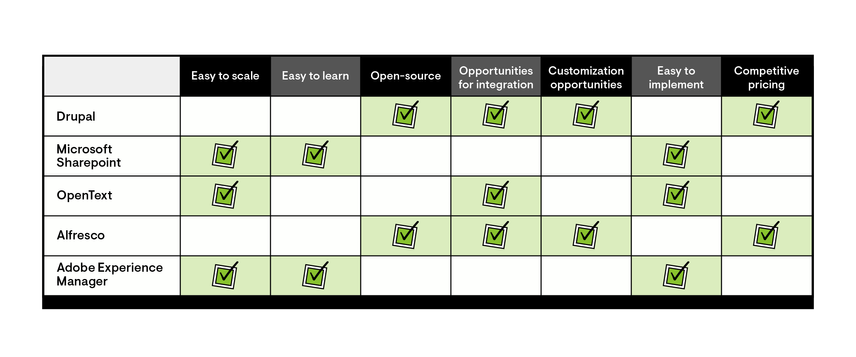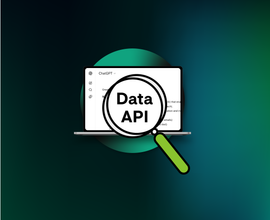Your Complete Guide to Enterprise Content Management Systems
To properly manage your content on an enterprise scale, you need to find the right platform that satisfies your needs. The right enterprise content management system can help you and other teams throughout your organization oversee your entire content lifecycle in one secure and unified location.
Learn how enterprise content management systems foster strong content workflows, improved collaboration, and increased security.
What are enterprise content management systems?
Enterprise content management (ECM) systems give organizations a centralized hub to manage their internal and external content throughout its lifecycle. Like a traditional content management system, ECMs allow content teams and writers to publish content on your customer-facing website, but they also impact teams across the larger organization.
Anything from training materials to HR documents to contracts can be stored within a single enterprise content management system, ensuring a fast, easy, and, above all, secure experience for authorized users. Unlike most traditional CMSs, this includes unstructured content, like emails, word documents, PDFs, and scanned images, which can be uploaded to your dedicated ECM system.
What is enterprise content management?
Enterprise content management is the process of unifying your entire content lifecycle to remove redundancies and improve collaboration across a large organization. Essentially, enterprise content management involves the following six steps:
- Import and store documents and content
- House documents in a digital hub (your enterprise content management system)
- Retrieve documents on any shared device
- Seamlessly share documents and processes across the organization
- Secure documents and information
- Repeat
In your normal day-to-day, you may have a lot of content, documents, images, and other important resources spread across a few different tools. While having several point solutions is fine for smaller organizations and individual contributors, it’s not feasible for a large enterprise organization to manage all of its content, customers, and stakeholders across several tools.
That’s where enterprise content management systems come in.
Why are enterprise content management systems important?
Besides the few reasons we’ve touched on, enterprise content management systems are important because they offer:
- Streamlined processes
- Improved collaboration
- Centralized information and content management
- Improved productivity and customer service
- Compliance and security oversight
Among other advantages, enterprise content management systems give everyone in your organization access to the same information, meaning collaboration and training are easier, which leads to better results. Centralizing your data and content also improves your organizational security and reduces the risk of breaches or issues around legal compliance. In short, enterprise organizations have too many moving parts to use several disparate tools. An enterprise content management system reduces organizational risk while improving productivity.
How does ECM software differ from traditional CMS?
A traditional CMS like WordPress is a point solution. It’s a system that helps an organization when it comes to publishing content on its website, but it doesn’t offer much beyond that, making it helpful for small- and medium-sized businesses.
An ECM, on the other hand, is more about storing all of an organization’s information in one place. While it can help companies publish and optimize web content, it can also help in the creation of that content as well. Companies can store, manage, and control not only the organization’s documents and information but also the specific processes and strategies that go into creating those documents.
Key features of enterprise content management systems
Earlier, we mentioned how enterprise content management systems help improve collaboration, legal compliance, and security, but let’s dive into the specific features that make an enterprise content management system critical for large organizations. Bear in mind that this is not a comprehensive list, and some enterprise content management systems will vary in the specific features they have, but generally, these are what separate an ECM system from CMS.
- Secure storage for documents across the organization, as offered by Confluence .
- The ability to write and publish content on your website like you would find in WordPress .
- The ability to track changes and updates to your site, like you’d find in ContentKing .
- Automated business processes and workflows
- Detailed analytics on content and site performance, like in Adobe Analytics .
- Comprehensive record keeping to help you stay compliant
- Opportunities for integrations with third-party vendors
An ECM system means changing the way that your entire organization works. Every team will work from the same platform. Not only does this improve the consistency and efficiency of your production, but it also means that the dissemination and sharing of information will improve, too.
In addition, an enterprise content management system has built-in fail-safes to make sure that your content is backed up properly, is compliant with laws and industry best practices, and that there is a record of any changes made within the ECM. Include the fact that enterprise content management systems allow for improved informational security by only allowing authorized users access to content, and it’s clear why large companies rely on ECMs for their content and data infrastructure.
Closed-source vs open-source enterprise content management systems
One consideration that’s important to make when it comes to enterprise content management systems is how they’re built and updated. This discussion quickly leads to the ideas of closed-source and open-source ECM software. So, what is the difference between closed and open-source enterprise content management systems?
An open-source enterprise content management system is an ECM that has opened its source code to the public, allowing anyone to inspect it and enhance it as they see fit. Oftentimes, this can lead to significant improvements to the original code. Open-source software ensures that more people get access and can learn from the source code, effectively democratizing the information.
On the other hand, closed-source ECM systems do not allow their source code to be viewed by the public. In fact, that information is proprietary, so a company could turn to legal action if its source code were modified.
Because nobody but the initial developers can modify the code, closed-source enterprise content management systems can often be more expensive than open-source, but closed-source also can be more secure.
What enterprise content management system is best for me?
There are several large names offering enterprise content management systems, like Microsoft, OpenText, Alfresco, Adobe Experience Manager, and Drupal. But when you’re deciding which one is best, you’ll need to consider your specific position in the market, where you are in your growth, and what your goals are going forward. That said, let’s break down a few of the big names in enterprise content management software and what they specifically offer.
Overall, the top platforms have several strengths in common, specifically around security, process automation, and content oversight. Key differences lie in their integration, scalability, and total cost.
Drupal
Drupal is a robust open-source content management platform that makes it easy for any user, regardless of their expertise, to quickly learn how to structure and manage their website. Specifically, Drupal users can tap into its open-source ecosystem to expand the capabilities of the platform and tailor it to their needs. Like a couple of the other ECM systems, we’ll go over, Drupal does allow for a lot of customization and flexibility in its features and integrations, but this can make it a bit tricky for beginners to fully leverage, implement, and optimize the platform for their specific needs.
Things to know:
- Customizable and versatile
- Open-source platform
- Competitive pricing
- Multisite management
- Flexible content modeling and content version control
- Search indexing
- Robust integrations
One of Drupal’s main advantages is the fact that it can integrate with over 24,000 free plug-ins and allows companies to completely customize their modules and workflows to make sure they’re seeing the most relevant information.
Microsoft Sharepoint
One of the biggest names in tech, Microsoft offers an enterprise content management system in the form of Sharepoint . Sharepoint is one of the most popular and widely adopted ECM systems on the market, which is no surprise given the name recognition. One main takeaway from Sharepoint is that it’s generally considered easy to implement and use. This is partially due to the fact that you’re using Microsoft Sharepoint pretty much right “out-of-the-box,” and only light customization is possible within the platform without reworking the code. So, ease of use may come with a tradeoff of less customizability.
Things to know:
- Integrates easily with Microsoft Office
- Advanced process and workflow automation
- Strong internal search and content tagging capabilities
- Closed-source platform
- Easy to use out-of-the-box
- Customization can be difficult without development
OpenText
OpenText is one of the leading ECM options in the market, but unlike options like Drupal and Alfresco, OpenText is not an open-source platform. As we discussed, open-source platforms have their code open to the public. This means that solutions like Microsoft and OpenText tend to cost more than open-source solutions, because users need to buy a license to use the platform directly from the company, which can also lead to a steep learning curve when starting with the platform.
However, OpenText offers a robust suite of features that will cover all of your content management needs on an enterprise level, including:
- Flexible to use and large breadth of features
- Solutions for process automation, compliance, archiving, analytics, and more.
- Great integration flexibility
- Powerful search, analytics, and reporting
- Closed-source platform
- Can be complex for beginners
Alfresco
Alfresco is another open-source platform that offers competitive prices and greater control and customization opportunities. The tradeoff can be a more complex setup process and more time to master the workflows than a platform like Microsoft Sharepoint, for instance.
- Open-source
- Competitive licensing costs
- Information management and content workflow features
- Robust integration options
- Easy to scale
- Flexible implementation
- Can have a steep learning curve
Adobe Experience Manager
Adobe Experience Manager is an enterprise content management platform that, like Microsoft Sharepoint, easily integrates with anything in the Adobe suite you already use. Adobe is not an open-source platform, so depending on your needs, costs may be higher than a platform like Alfresco or Drupal, but Adobe does offer an easier and less complex setup and learning curve than OpenText and Alfresco have had for some. Like Microsoft Sharepoint, Adobe gives users just about everything they need to manage the content lifecycle from beginning to end from the start but doesn’t offer as much opportunity for customization.
- Excellent for secure cloud content management
- Easy to set up and use
- Strong external sharing and mobility features
- Closed-source
- Great for collaboration
Ultimately, with many of these platforms there is an inherent trade-off. Do you want more customizability and personalization? Then it may be more difficult and time consuming to implement and fully leverage the power of the platform.
Below, we’ve compiled a helpful matrix that breaks down enterprise content management systems and what features they offer.

Summarizing enterprise content management systems
Enterprise-level organizations have a lot of plates spinning. In order to run efficiently and provide a positive experience for their employees, business stakeholders, and customers, they need to have their information, data, and content housed in a single location. Centralized and secure information improves collaboration, security, and productivity across the organization. It also makes it easier to scale as your organization grows.
Enterprise content management systems also secure your information and data from fraud and increasingly common data breaches, which is critical for the future of any organization. That attention to security also helps to ensure legal compliance. Ultimately, an enterprise content management system is critical for any large company that is looking to scale. Reduce your organizational risk with enterprise content management.







